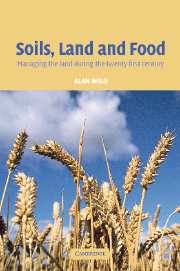Book contents
- Frontmatter
- Contents
- Preface
- Acknowledgements
- 1 Managing land for food production in the twenty-first century: an outline
- 2 Natural resources for sustainable land management
- 3 The development of agriculture and systems of land management
- 4 Maintaining and improving soil fertility
- 5 Land degradation and its control
- 6 Raising yields: use of fertilizers
- 7 Raising yields: water for rainfed crops and irrigation
- 8 Managing change of land use: seven examples
- 9 Increasing and sustaining agricultural production
- 10 Increasing agricultural production: the examples of Africa, India and China
- 11 Prospects and uncertainties
- References
- Index
2 - Natural resources for sustainable land management
Published online by Cambridge University Press: 05 June 2012
- Frontmatter
- Contents
- Preface
- Acknowledgements
- 1 Managing land for food production in the twenty-first century: an outline
- 2 Natural resources for sustainable land management
- 3 The development of agriculture and systems of land management
- 4 Maintaining and improving soil fertility
- 5 Land degradation and its control
- 6 Raising yields: use of fertilizers
- 7 Raising yields: water for rainfed crops and irrigation
- 8 Managing change of land use: seven examples
- 9 Increasing and sustaining agricultural production
- 10 Increasing agricultural production: the examples of Africa, India and China
- 11 Prospects and uncertainties
- References
- Index
Summary
INTRODUCTION
To function successfully, terrestrial ecosystems require light, water, air, a supply of essential mineral nutrients and a suitable temperature. All agricultural systems also have these biological and physical requirements, but in addition depend on socio-economic conditions, referred to in later chapters.
Both natural and agricultural systems are adapted to local environmental conditions and they therefore vary greatly over the Earth's surface. Their nature depends on climate, including solar radiation, temperature and amount and seasonal distribution of rainfall, supply of soil water and type of soil. These are natural resources that determine the way the land is managed, the agricultural system used and the system's productivity, including crop yield. The total production from arable agriculture depends on both annual crop yield and the area of land that is cultivated; in turn, these are determined by the demand for products.
AREA OF LAND
Of the total land area of the Earth about 10 per cent (14.8 million km2) is cropland, and in any year about two-thirds of this area grows a crop. Part of the rest is used for grazing by domesticated animals. The remainder supports natural vegetation (more usually, secondary or derived vegetation), is desert, is covered by snow or ice, or is too steep or too cold for any agricultural use. Although the total land area is not constant, the rate of change is very small over a time span of 100 years.
- Type
- Chapter
- Information
- Soils, Land and FoodManaging the Land during the Twenty-First Century, pp. 9 - 22Publisher: Cambridge University PressPrint publication year: 2003



